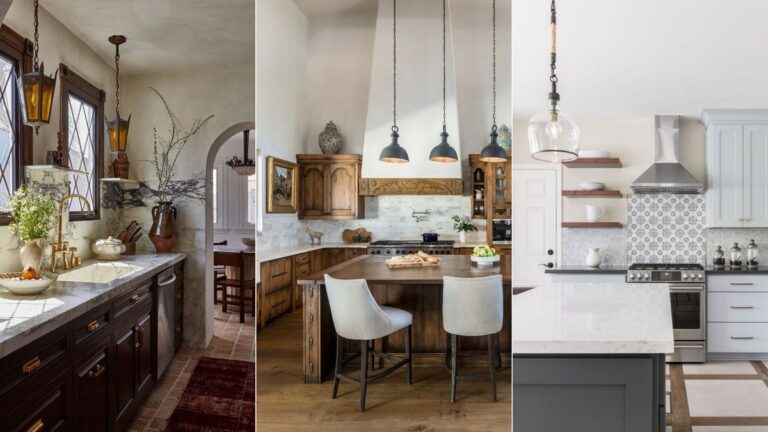When you think of a Spanish kitchen, you probably think of natural materials, stone tile, iron accents, and a warm space full of charm — and you're right, but there are many different styles of Spanish interior design, so you can find an aesthetic that suits your tastes.
This European-inspired kitchen design style is one of the most popular in the United States, thanks to the Spanish architecture found throughout the U.S. From earthy color palettes to natural stone finishes and dark metal accents, there are plenty of stunning ways to bring a Spanish touch to your kitchen.
From traditional terracotta floors and wooden cabinets to dark metal fixtures and earthy tones, these Spanish kitchens incorporate all of the style's core design elements, so there's one to suit any space.
What are the characteristics of Spanish kitchens?
Spanish kitchens can have a variety of aesthetic looks depending on the style. A Spanish Revival kitchen is slightly different than a Spanish Colonial or Traditional Spanish style.
But through all these variations, some key elements remain constant: At its core, a Spanish kitchen should feel warm, inviting, and above all, lived-in. The countertops are never pristine, and the pots, pans, and décor show their age.
Spanish kitchens have a touch of tradition. Terracotta tiles are commonly used, especially for flooring and backsplashes. They are still handcrafted by Spanish artisans, but recycled tiles are also available.
As well as terracotta tiles, wrought iron finishes are also common in Spanish kitchens. From kitchen cabinet handles and drawer pulls to vintage chandeliers and pendant lights, incorporating iron finishes in these pieces adds to the depth and charm commonly found in Spanish kitchens, providing a beautiful contrast to the more neutral colour palettes typically used.
What color scheme is best for a Spanish-style kitchen?
There's a common misconception that Spanish kitchens are dark, but neutral colours are favoured in these spaces, with walls usually in warm whites and limed or plastered finishes not uncommon to match the commonly used wooden cabinetry.
Alongside neutrals, earthy colours are also typical of Spanish kitchens: terracotta, brown, auburn and orange shades. These colours bring the outdoors inside and are reminiscent of the Mediterranean style that is so prevalent in European kitchen design.
5 stunning Spanish kitchen ideas to try
Whether you're designing an authentic Spanish-style home kitchen or simply want to incorporate some Spanish elements into your plans, these tips, tricks, and ideas from interior designers will help you make the right design choices.
1. Choose natural wood cabinets
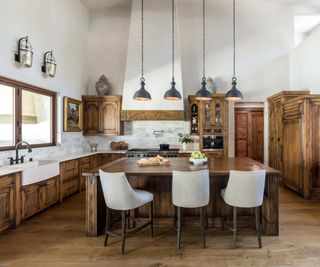
(Image courtesy of Kristen Elizabeth Design)
Kitchen cabinets take up a large part of your kitchen, so choosing the right materials and finishes is important when embracing the Spanish style. While some interior design trends call for bright, vibrant colors, Spanish-style kitchens are the complete opposite.
“Spanish kitchens are characterised by a warm, inviting atmosphere with an emphasis on natural materials and earthy colours. Wooden kitchen cabinets feel authentic, original and timeless – they add just the right amount of rustic flair that is typical of traditional Spanish kitchens,” says Kristen Fiore of Kristen Elizabeth Design.
“In my own kitchen design project, I incorporated Spanish style with hand-painted tiles, wooden accents and cabinetry, and iron fixtures. I also incorporated color into the ceramics, just as is common in Spain and Portugal,” she adds.
2. Add a striking countertop
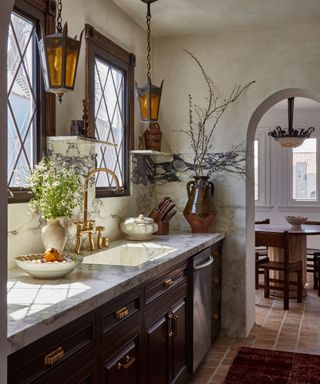
(Image courtesy of Drew Michael Scott)
There are many different types of Spanish-style kitchens, but the Spanish revival trend seems to be making a comeback, especially in and around Los Angeles, where many homes in this style are in need of restoring their original features.
“When we purchased our 1920s Spanish Revival home, the first thing we wanted to restore was the kitchen. It had been completely gutted and had none of the original charm or character of the home. We loved the creativity that could be brought to this space,” says Drew Michael Scott of Lone Fox.
“I wanted the countertops to have some personality, so I spent a lot of time browsing stone stores and found this beautiful Calacatta Monet stone slab with a really interesting grain pattern that really helped set the tone for the rest of the kitchen,” he explains.
“The cabinets were new, so we left them as they were and painted them in Benjamin Moore's Van Buren Brown and plastered the walls and ceiling for a stone-like finish. Paver floor tiles in the Cle pantry really tie it all together. We laid them in a traditional offset brick pattern with piped grout to give it a 'handmade feel,'” adds Drew.
3. Add color and pattern with tiles
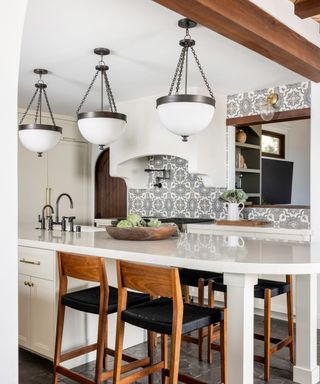
(Images courtesy of Dmar Interiors/Molly Rose Photo)
Although Spanish-style kitchens are primarily made up of earth tones and natural materials, there is still room for more colorful interpretations. Traditional Spanish-style kitchens incorporate color through their décor, but this can be incorporated into any kitchen design.
“The Spanish kitchen is the heart of the home, a place for lively family gatherings and conversation. Light-coloured kitchen tiles, textiles and ceramics add a bright and vibrant feel,” explains Kristen.
From slate and terracotta floor tiles to patterned encaustic tiles on the walls, tiles are a key element in Spanish-style kitchens. In this kitchen, the grey-toned wall tiles add interest and character to the kitchen without overwhelming the space.
“The overall feel of a Spanish kitchen is one of comfort, relaxation, and a strong sense of place,” adds Kristen, so be sure to maintain that vibe when incorporating decorative elements.
4. Create texture with plaster walls
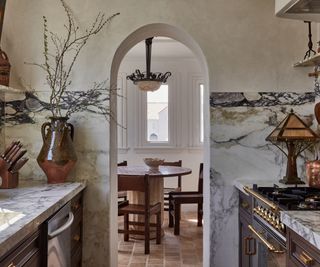
(Image courtesy of Drew Michael Scott for Lone Fox)
A Spanish-style kitchen can feel truly authentic when you mix old and new, and reclaimed materials are a great place to start, including tiles, wood and trim.
“To bring Spanish style into your kitchen space, consider rustic materials and traditional design elements, such as terra cotta tile, reclaimed wood and textured plaster walls,” suggests interior designer Kate Nixon.
These old elements work great in the kitchen when combined with more decorative details. Consider the hardware you choose and how it works with the light fixtures. “Decorative ceiling beams, a dramatic range hood, iron pendant lights, and joinery hardware evoke the spirit of Mediterranean hospitality,” adds Kate.
5. Opt for wrought iron accents
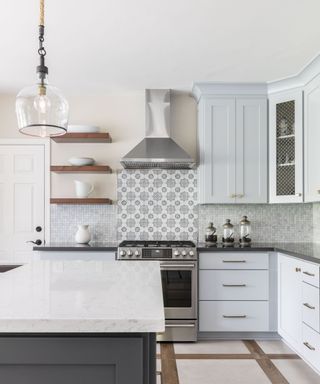
(Image courtesy of Kristen Elizabeth Design)
Any kitchen design needs hardware in the right style and finish to feel authentic, and in a Spanish-inspired kitchen, wrought iron hardware is a must, especially if the space doesn't have quite the Spanish feel.
“Wrought-iron light fixtures, cabinet hardware, and other accents echo rustic, natural materials and aesthetics,” says Kristen. In this kitchen, the lower cabinets feature wrought-iron drawer pulls, and the pendant lights also feature wrought-iron details.
Although these may seem like subtle details and are not immediately eye-catching, they are important design elements of a Spanish kitchen. If you were to simply replace them with gold and chrome, the design would quickly lose its European impact.
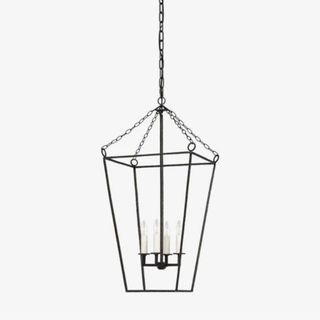
Malloy Open Frame Forged Lantern
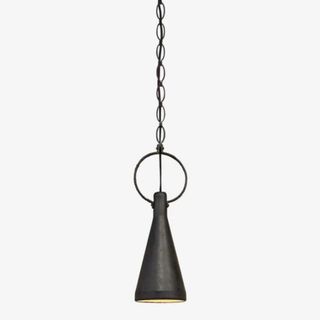
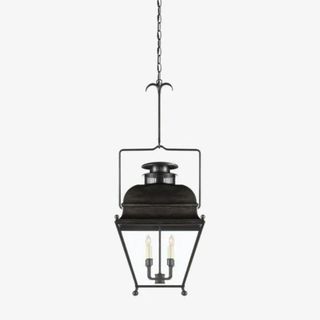
Spanish-style kitchens rely on a warm, inviting atmosphere, natural materials, and sophisticated details. Keep the color palette in warm neutrals and earthy tones, and metal accents in wrought iron for an authentic look. Spanish kitchens are unique, charming, and unpretentious, so keep this in mind when incorporating Spanish influences into your design.


